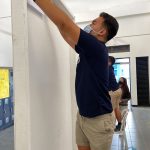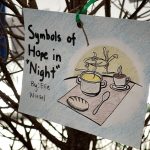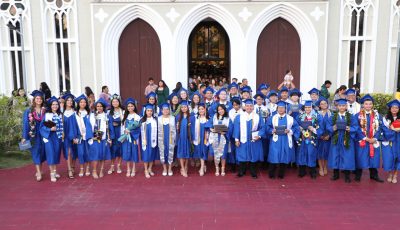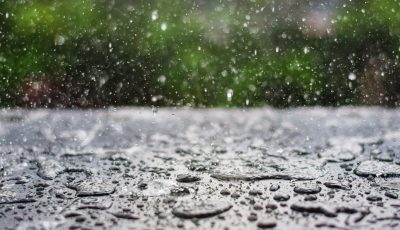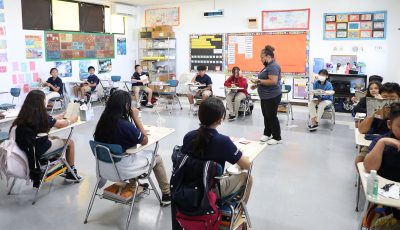MCS juniors learn about Holocaust in interactive displays
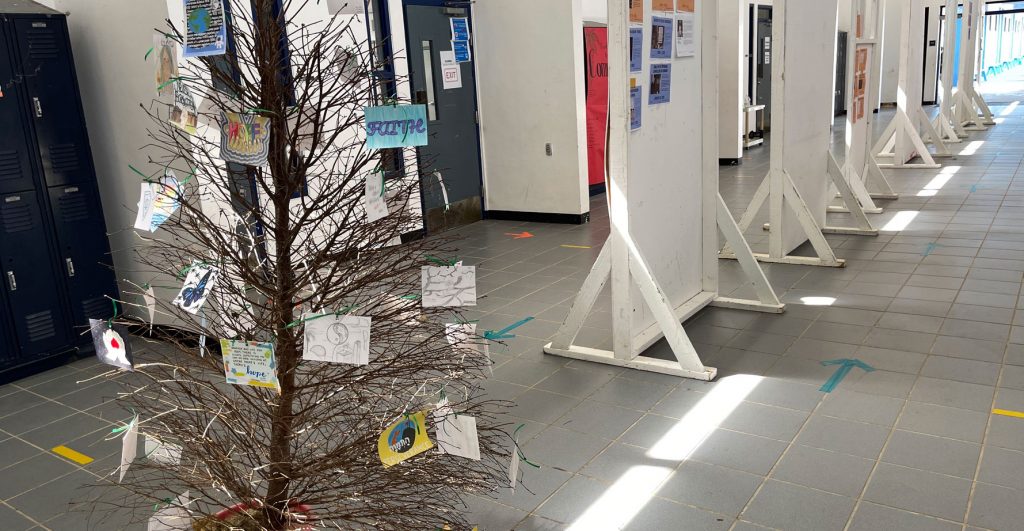
In learning about the Holocaust, Juniors at Mount Carmel School created this Holocaust Memorial, which runs along the second-floor hallway of the school’s Maturana Building. The students’ poems and artwork about the Holocaust were hung on a tree that stands at the beginning of student-made Holocaust Memorial. (CONTRIBUTED PHOTOS)
Mount Carmel School Juniors recently learned more about the Holocaust with interactive lessons that linked their American Literature course with AP United States History. The lesson lasted for several weeks and engaged students in a wide variety of activities, including deep readings, Socratic Seminars, and creating a Holocaust Memorial on campus.
English teacher Keiko Yamagata used several resources from the Southern Poverty Law Center and Facing History and Ourselves to design a lesson that connected lessons about the Holocaust with current issues about hate and intolerance. During the first semester, Juniors read short stories, speeches, and letters about the Holocaust, which prepared them to read Night by Elie Wiesel in the second semester. Students also created their own poems in the likeness of First They Came by Martin Neimoller, engaged in Socratic Seminars, and created art pieces. This led to learning about Choiceless Choices, the causes of hate, and the CNMI’s Hate Crimes Act of 2021. After five weeks, the students brought closure to all these lessons with teach-backs of the many ways they can combat hate.
Yamagata was moved by students’ interest in learning about the Holocaust. “The students’ journals, class discussions, and projects clearly indicated their interest in human behavior, faith and religion, decision-making, just to name a few.” Based on that interest, Yamagata felt compelled to expand the lesson. “As we were nearing the end of Wiesel’s memoir, I felt that there were other critical lessons that still needed to be facilitated and this was that teachable moment.”
To reinforce what Yamagata was covering in her American Literature course, school president and AP United States History teacher Dr. Galvin Deleon Guerrero also took students on a deep dive into learning about the Holocaust.
After reading their textbook and watching a few videos explaining what the Holocaust was and how it happened, students used resources provided by the U.S. Holocaust Memorial Museum to study the personal profiles of 40 victims of the Holocaust. Students then placed their profile cards along a timeline that ran along one of the campus hallways. Students then discussed 20 laws and decrees and 40 historical events that were connected to the Holocaust, all of which were then placed along the timeline in the hallway. That timeline thus became a Holocaust Memorial that demonstrated the personal impact that laws, decrees, and historical events had on victims of the Holocaust. To complement the memorial, Yamagata had her students’ poems and art pieces hung on a deciduous tree displayed at the beginning of the timeline. The entire lesson concluded with a screening of Steven Spielberg’s Academy Award winning film about the Holocaust, Schindler’s List.
Regarding the significance of the lesson, Deleon Guerrero said, “With the recent resurgence of white supremacy in American and Europe, compounded by a rising number of people who either don’t know about or don’t believe in the Holocaust, now, more than ever, we need to learn this history to ensure that it never happens again.”
Many students were moved by what they learned about the Holocaust.
For Kiana Propst, “Learning more about the Holocaust really helped me open my eyes to what truly happened.” Propst also connected what she learned to current events. “It helped me reflect on different issues that continue to this day.”
For Christian Guerrero, learning about the Holocaust was more than just a history lesson. “I will remember these victims and their stories. Though most have passed, never forgetting is the only way to bring them honor and to keep their memories alive.”
Richard Villagomez was particularly impacted by the lesson. “While I’ll never truly know what it felt like to live through the Holocaust, learning about the Holocaust has made it feel more and more real to me. Reading the profiles and personal accounts of the victims has helped me have a deeper realization that every single victim of the Holocaust had their own life, and I find it truly inspiring that they found their own ways to fight against the absolute cruelty that they were put through.”
Based on what he learned, Villagomez believes more people should learn about the Holocaust. “It’s absolutely important to help others realize that the Holocaust is more than just a series of facts and figures—these were real people, fighting against real brutality—and we owe it to every single one of these victims to educate ourselves and help educate others.”
According to the U.S. Holocaust Memorial Museum, “The Holocaust was the systematic, state-sponsored persecution and murder of six million Jews by the Nazi regime and its allies and collaborators. The Nazis came to power in Germany in January 1933. They believed that the Germans belonged to a race that was ‘superior’ to all others. They claimed that the Jews belonged to a race that was “inferior” and a threat to the so-called German racial community.”
For more information about the Holocaust, visit https://encyclopedia.ushmm.org/content/en/article/introduction-to-the-holocaust. (PR)
- Mount Carmel School junior Richard Villagomez posts profiles of Holocaust victims on a timeline of laws, decrees, and historical events as part of a Holocaust Memorial at the school.
- A piece of student artwork about the Holocaust that is part of a Holocaust Memorial that students recently erected at Mount Carmel School.



